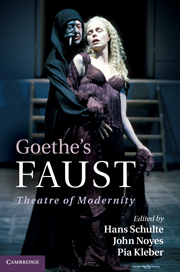Book contents
- Frontmatter
- Contents
- List of illustrations
- List of contributors
- Preface
- List of abbreviations
- Introduction
- PART I MODERNITY
- 1 Faust – today
- 2 Mephisto and the modernization of evil
- 3 Mephisto is the devil – or is he?
- 4 ‘Schwankende Gestalten’: virtuality in Goethe's Faust
- 5 Amnesia and anamnesis in Goethe's Faust
- 6 Magicians of modernity: Cagliostro and Saint-Simon in Goethe's Faust II
- 7 The blind Faust
- 8 From Faust to Harry Potter: discourses of the centaurs
- 9 Mistra and the Peloponnese in Goethe's Faust II
- 10 Goethe and the grotesque: the ‘Classical Walpurgis Night’
- 11 Re-defining classicism: antiquity in Faust II under the sign of the Medusa
- 12 Diabolical entrapment: Mephisto, the angels and the homoerotic in Goethe's Faust II
- PART II THEATRE
- Select bibliography
- Index
- References
11 - Re-defining classicism: antiquity in Faust II under the sign of the Medusa
Published online by Cambridge University Press: 01 June 2011
- Frontmatter
- Contents
- List of illustrations
- List of contributors
- Preface
- List of abbreviations
- Introduction
- PART I MODERNITY
- 1 Faust – today
- 2 Mephisto and the modernization of evil
- 3 Mephisto is the devil – or is he?
- 4 ‘Schwankende Gestalten’: virtuality in Goethe's Faust
- 5 Amnesia and anamnesis in Goethe's Faust
- 6 Magicians of modernity: Cagliostro and Saint-Simon in Goethe's Faust II
- 7 The blind Faust
- 8 From Faust to Harry Potter: discourses of the centaurs
- 9 Mistra and the Peloponnese in Goethe's Faust II
- 10 Goethe and the grotesque: the ‘Classical Walpurgis Night’
- 11 Re-defining classicism: antiquity in Faust II under the sign of the Medusa
- 12 Diabolical entrapment: Mephisto, the angels and the homoerotic in Goethe's Faust II
- PART II THEATRE
- Select bibliography
- Index
- References
Summary
This chapter enquires into the image of antiquity which Goethe employed in order to come to terms with the experience, central to his age, that the horrors of history seem not to decline over time but to increase. Classicism generally assumes not only that antiquity represents the aesthetic model for modernity, it also offers an ideal of human perfection that modernity must emulate. The classicist understanding of artistic representation prevalent in Goethe's time was, however, challenged by the apparent failures of two tenets of philosophical thought: the striving after human perfection, and the humanism of the optimistic Enlightenment. If the underlying picture of antiquity was to serve as an artistic mirror of even the most advanced aesthetic, political and social problems of the age, it would have to incorporate the historical resistance to the Enlightenment's very concept of humanity. Goethe experienced the nineteenth century not as increasingly humane but, on the contrary, as increasing in its horrors. In the paralipomena to Faust ii, he captured this experience in an image that gave an ancient myth a striking modernity: the image of the incessantly growing Medusa. The picture of antiquity he developed in the second and third acts can be understood as an aesthetic attempt to adapt classicism to the historical realization that the growing Medusa could not in his time be stopped.
- Type
- Chapter
- Information
- Goethe's FaustTheatre of Modernity, pp. 156 - 173Publisher: Cambridge University PressPrint publication year: 2011



